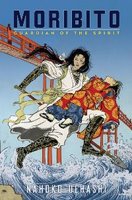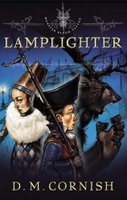
One of the first things I had to learn about writing for children back when I was getting started was that kids' books were about kids. They got the best lines. The action needed to be around them. In a good kids' book, the kids saved themselves, adults didn't save them.
Moribito: Guardian of the Spirit by Nahoko Yehashi, winner of the Mildred L. Batchelder Award, breaks that rule in spades.
Take a look at that beautiful cover. The stunning spear-wielding warrior is a thirty-year-old woman described on page one as having a face "tanned and beginning to show fine wrinkles." The cover illustrates the opening scene in which Balsa, a martial artist for hire, saves an eleven-year-old prince. Note that we don't even see his face. The balance of power between characters is made clear before the book is even opened.
The story opens with Balsa. It closes with Balsa. She is the character who changes as a result of the events in the story. An argument can be made that nothing changes for the prince, who functions as a sort of vessel for a spirit egg that has been placed inside him without his knowledge.
Moribito: Guardian of the Spirit is told in the third person with point-of-view shifts among characters by chapter. These shifts occur among adult characters until half way through the book when a chapter from the child's point of view appears. Later in the book, point-of-view shifts appear within chapters, including shifts to the young prince. I don't believe he gets another chapter to himself, though. That's probably just as well because he's nowhere near as interesting as all the grown-ups around him.
One strange YA book? Yes, indeed. Until you realize that the Mildred L. Batchelder Award is given "for the most outstanding children’s book originally published in a language other than English in a country other than the United States, and subsequently translated into English for publication in the United States." (Got that?) Moribito: Guardian of the Spirit is a Japanese book translated by Cathy Hirano. It's the first in a series that's supposed to have sold 1.5 million copies in Japan and has appeared there in both anime and manga.
I know that one title does not make a statistically significant number, but after reading Moribito I'm wondering if kids in other cultures do read about adults, whereas here, not so much.
Cartoon Network's Adult Swim aired the anime version of Moribito: Guardian of the Spirit last year. That ended in January, though.
Scholastic will be publishing the second Moribito: Guardian of the Darkness this summer.
Training Report: Between yesterday and today I did four 365 Story Project segments. That would sound a whole lot better if I hadn't missed three, maybe four days for the holiday weekend. Plus, I've decided to replace a couple of yoga segments I did a while back with an ice skating segment I did today and another I plan to do tomorrow. So I'm thinking I'm just getting further and further into the hole. I also spent some time today trying to sign up for AmazonConnect, which is supposed to allow authors to do some kind of promotion on the pages advertising their books. However, when I tried to do something called "verifying," I got a message saying there was some kind of problem, hope you don't mind too much. Yes, this is minor Amazon news compared to what was happening there this weekend.
Viewing: Blog Posts Tagged with: YA adventure stories, Most Recent at Top [Help]
Results 1 - 2 of 2
Blog: Original Content (Login to Add to MyJacketFlap)
JacketFlap tags: Reader response, YA adventure stories, Add a tag
Blog: Original Content (Login to Add to MyJacketFlap)
JacketFlap tags: YA adventure stories, fantasy, Monster Blood Tattoo, Reader response, Add a tag

Lamplighter by D.M. Cornish is the second volume in his Monster Blood Tattoo serial. And make no mistake, this is a serial. Though the main character reaches the end of his journey in the first book, The Foundling, it's clear that the book is not a completed story. The second book has a climactic event, but no resolution. Plus a lot of characters are introduced in Lamplighter who don't do a great deal, which suggests to me that we'll be seeing them in the next book. Lady Dolours, for instance, is featured on the cover but plays virtually no role in this book. And, finally, the lengthy Explicarium/Glossary at the end of the book includes many entries referring readers back to Book One.
To enjoy these books, you need to accept the fact that this is a serial and not fight it. So go read the first book before you start this one.
Monster Blood Tattoo takes place in a world perhaps comparable to 17th/18th century Europe, though a 17th/18th century Europe overrun with monsters with whom humans are in constant conflict. A whole array of different types of human monster fighters exist, many of them having subjected themselves to surgical procedures that will give them inhuman powers. A human who has killed a monster gets tattooed with the monster's blood.
The Foundling was a journey story in which our main character, the orphan Rossamund, travels to Wintersmill where he is to train as a lamplighter, one of the people who light lamps along the highway late in the day and then put them out early in the morning. A journey story has a built-in narrative drive, you could say. Plus The Foundling had a marvelous character in the monster fighter for hire, Europe, with whom Rossamund falls in.
Lamplighter is about identity. Rossamund is becoming a lamplighter. Is he also a monster lover and thus a criminal? Why is he so strong? Who is he? That's interesting, but not necessarily something that moves a story along. His lamplighter training is very military in nature and takes place in a military-type fortress. Military training doesn't have the built-in narrative drive of a journey story. What we get here is not very exciting training broken up with fantastic monster attacks. (From what I've heard, that's similar to real military life--unexciting preparation broken up by all-too-exciting engagements.) I mean, really fantastic monster attacks. The last one was especially good, and I didn't see it coming.
The plot for the entire series does thicken in this volume. Someone within the military is creating monsters, though we don't know why. The bad guys appear to be...bureaucrats. Though we don't know, yet, what they have to gain.
The world of Monster Blood Tattoo is very elaborate, with creatures and all kinds of invented job categories among the humans as well as an invented culture within which they live. I found the reading this time around a little more complex. I had to use the glossary quite frequently. I don't think I even knew there was one in the first book until I finished. The backflap says Cornish worked fifteen years creating Half-Continent in which the story takes place. I can believe it.
As I was reading the book, I couldn't help but think how difficult it must have been to edit. Part of an editor's job is to look for inconsistencies and to make sure the world the author has created--whether it's an elaborate new one as in Monster Blood Tattoo or a grade school world we might know today--is believable. In addition to all the different types of monsters and monster fighters (some of whom are called different things within the military), this book uses invented countries, roads, weapons, holidays, days of the week and months of the year. Someone had to keep track of all that and make sure it made sense within the context of the book. I hope he wasn't trying to work on any other books at the same time.
One other interesting point about this book--the women. The world of Monster Blood Tattoo seems to be male dominated. All but one of the lamplighters is a man. Women appear as nurses and cooks and innkeepers. And yet you also have these incredibly powerful women monster fighters. Killers. The men in the story respect and fear them. Personally, I love women who kick ass, and the women who do so in this serial are a big draw for me.
While I can't say I was as big a fan of Lamplighter as I was of The Foundling, I did find myself missing the world within this book when I'd finished it. I suffered a little withdrawal.
By the way, Lamplighter has been nominated for a Cybil.



I read a lot of Japanese YA. I would say that the majority is about teenagers, but the disparity isn't quite as intense as it is in the US. You'll see examples, especially in contemporary or near-future settings, where the main characters are adults -- usually youngish adults, in their twenties -- occupying roles that teenagers might not be able to occupy: soldiers, police officers, detectives, professional musicians or actors or fashion designers. But I do think that Moribito is an outlier in that respect.
Okay. That makes Moribito even more interesting.
As luck would have it, I've been listening to Outliers.